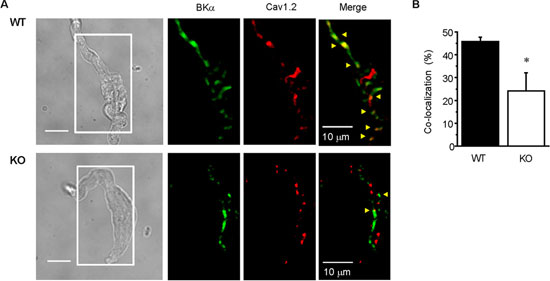Overview
Cat #:
APC-107
Alternative Name Large conductance calcium-activated potassium channel subfamily M subunit alpha-1, BKCa alpha, Maxi K+, Slo1
Lyophilized Powder yes
Type: Polyclonal
Host: Rabbit
Reactivity: H, M, R
Immunogen
- Peptide (C)STANRPNRPKSRESRDK, corresponding to amino acid residues 1184-1200 of mouse KCNMA1 (Accession number Q08460). Intracellular, C-terminal part.
Accession (Uniprot) Number Q08460
Gene ID 16531
Peptide confirmation Confirmed by amino acid analysis and mass spectrometry.
Homology Rat - identical; human, bovine, chicken, dog - 16/17 amino acid residues identical.
RRID AB_2040091.
Purity Affinity purified on immobilized antigen.
Form Lyophilized powder. Reconstituted antibody contains phosphate buffered saline (PBS), pH 7.4, 1% BSA, 0.05% NaN3.
Form Lyophilized powder. Reconstituted antibody contains phosphate buffered saline (PBS), pH 7.4.
Isotype Rabbit IgG.
Storage before reconstitution The antibody ships as a lyophilized powder at room temperature. Upon arrival, it should be stored at -20°C.
Reconstitution 25 μl, 50 μl or 0.2 ml double distilled water (DDW), depending on the sample size.
Reconstitution 0.2 ml double distilled water (DDW).
Antibody concentration after reconstitution 0.6 mg/ml.
Storage after reconstitution The reconstituted solution can be stored at 4°C for up to 1 week. For longer periods, small aliquots should be stored at -20°C. Avoid multiple freezing and thawing. Centrifuge all antibody preparations before use (10000 x g 5 min).
Standard quality control of each lot Western blot analysis.
Applications: ICC, IF, IHC, IP, WB
Cited Applications: ICC*, IHC*, IP*
Western blot
- Rat brain membranes (1:500).
 Western blot analysis of rat brain membranes:1. Anti-KCNMA1 (KCa1.1) (1184-1200) Antibody (#APC-107), (1:500).
Western blot analysis of rat brain membranes:1. Anti-KCNMA1 (KCa1.1) (1184-1200) Antibody (#APC-107), (1:500).
2. Anti-KCNMA1 (KCa1.1) (1184-1200) Antibody, preincubated with KCNMA1/KCa1.1 (1184-1200) Blocking Peptide (#BLP-PC107).
Immunoprecipitation
- Rat brain lysate (4μg). Human cardiac fibroblasts (1:750) (Wang, Y.J. et al. (2006) J. Membrane Biol. 213, 175.).
Immunohistochemistry
- Rat penis.
Immunocytochemistry
- E9 chick CG neurons (Jha, S. and Dryer, S.T. (2009) FEBS Lett. 583, 3109.).
Scientific background
KCa1.1 (KCNMA1, BKCa, Maxi K+ or slo) is part of a structurally diverse group of K+ channels that are activated by an increase in intracellular Ca2+. KCa1.1 shows a large single channel conductance when recorded electrophysiologically and hence its name. It differs from the rest of the subfamily members in that it can be activated by both an increase in intracellular Ca2+ and by membrane depolarization.
KCa1.1 is expressed in virtually all cell types where it causes hyperpolarization and helps to connect intracellular Ca2+ signaling pathways and membrane excitability.
Indeed, KCa1.1 channels have a crucial role in smooth muscle contractility, neuronal spike shaping and neurotransmitter release.
Application key:
CBE- Cell-based ELISA, FC- Flow cytometry, ICC- Immunocytochemistry, IE- Indirect ELISA, IF- Immunofluorescence, IFC- Indirect flow cytometry, IHC- Immunohistochemistry, IP- Immunoprecipitation, LCI- Live cell imaging, N- Neutralization, WB- Western blot
Species reactivity key:
H- Human, M- Mouse, R- Rat
Lyophilized Powder
Image & Title:  Expression of BKCa in mouse mesenteric cells.A. Immunocytochemical staining of mouse mesenteric smooth muscle cells. Staining of BKCa using Anti-KCNMA1 (KCa1.1) (1184-1200) Antibody (#APC-107) (green) and CaV1.2 (red) in WT (upper) and Caveolin-1 KO (lower) mice. BKCa and CaV1.2 co-localization is shown in yellow (arrowheads). B. Ratio of BKCa and CaV1.2 co-localization particle number to total BKCa particle number in WT (n = 8) and KO (n = 7) myocytes (*, p < 0.05).Adapted from Suzuki, Y. et al. (2013) with permission of the American Society for Biochemistry and Molecular Biology.
Expression of BKCa in mouse mesenteric cells.A. Immunocytochemical staining of mouse mesenteric smooth muscle cells. Staining of BKCa using Anti-KCNMA1 (KCa1.1) (1184-1200) Antibody (#APC-107) (green) and CaV1.2 (red) in WT (upper) and Caveolin-1 KO (lower) mice. BKCa and CaV1.2 co-localization is shown in yellow (arrowheads). B. Ratio of BKCa and CaV1.2 co-localization particle number to total BKCa particle number in WT (n = 8) and KO (n = 7) myocytes (*, p < 0.05).Adapted from Suzuki, Y. et al. (2013) with permission of the American Society for Biochemistry and Molecular Biology.
 Expression of BKCa in mouse mesenteric cells.A. Immunocytochemical staining of mouse mesenteric smooth muscle cells. Staining of BKCa using Anti-KCNMA1 (KCa1.1) (1184-1200) Antibody (#APC-107) (green) and CaV1.2 (red) in WT (upper) and Caveolin-1 KO (lower) mice. BKCa and CaV1.2 co-localization is shown in yellow (arrowheads). B. Ratio of BKCa and CaV1.2 co-localization particle number to total BKCa particle number in WT (n = 8) and KO (n = 7) myocytes (*, p < 0.05).Adapted from Suzuki, Y. et al. (2013) with permission of the American Society for Biochemistry and Molecular Biology.
Expression of BKCa in mouse mesenteric cells.A. Immunocytochemical staining of mouse mesenteric smooth muscle cells. Staining of BKCa using Anti-KCNMA1 (KCa1.1) (1184-1200) Antibody (#APC-107) (green) and CaV1.2 (red) in WT (upper) and Caveolin-1 KO (lower) mice. BKCa and CaV1.2 co-localization is shown in yellow (arrowheads). B. Ratio of BKCa and CaV1.2 co-localization particle number to total BKCa particle number in WT (n = 8) and KO (n = 7) myocytes (*, p < 0.05).Adapted from Suzuki, Y. et al. (2013) with permission of the American Society for Biochemistry and Molecular Biology.For research purposes only, not for human use
Last Update: 25/03/2025
Specifications
Citations
Citations
